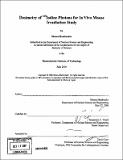Dosimetry of ¹²⁵Iodine protons for in vivo mouse irradiation study
Author(s)
Hembrador, Sheena (Sheena Marie C.)
DownloadFull printable version (2.424Mb)
Other Contributors
Massachusetts Institute of Technology. Dept. of Nuclear Science and Engineering.
Advisor
Jacquelyn C. Yanch.
Terms of use
Metadata
Show full item recordAbstract
The biological effects of acute, high doses of radiation are well understood. However, the effects of chronic, low doses are not as clear. Mice irradiation experiments to study the correlation of biological effects with chronic low dose rates are underway in order to make conclusions about the effects of low doses. Yet, in order to do so, the level of dose provided to the animals must be determined. This paper examines methods of ascertaining the dose rate delivered to mice by photons from an 125Iodine filled flood phantom source. Two distinct methods were used. First, Optically Stimulated Luminescence (OSL) Dosimeters were placed in an array over an area slightly larger than the irradiation area. The dose equivalent they each reported was recorded weekly. Secondly, a series of simulations were performed using MCNP to calculate the expected dose equivalent reported by those dosimeters. Comparison of the dosimeters' recorded dose to MCNP's calculated dose showed agreement within experimental and statistical uncertainty for 82% of the measurements. This high level of agreement demonstrates that the MCNP simulation approach produces reliable results. After this was shown, other MCNP simulations were performed to determine the dose equivalent to the mice in cages placed above the 125I filled phantom. The simulation showed an average dose equivalent of 656 t 108 mrem per week, with a range of 866 t 33 mrem/week to 399 t 18 mrem/week. The dosimetry methods developed in this report are not unique to this dose level, and can be used in future mouse studies to determine dose rates at other orders of magnitude.
Description
Thesis (S.B.)--Massachusetts Institute of Technology, Dept. of Nuclear Science and Engineering, 2006. Includes bibliographical references (leaf 47).
Date issued
2006Department
Massachusetts Institute of Technology. Department of Nuclear Science and EngineeringPublisher
Massachusetts Institute of Technology
Keywords
Nuclear Science and Engineering.